There is something singularly unique about the mountains that define the eastern border of the Salt Lake Valley. I don't know if it's the almost sculpted definition provided by the deep canyons and muscular
ridgelines, or the sheer and abrupt rises from the valley floor that so fascinate me about the Wasatch Mountains, but every time I find myself in the Salt Lake area I am unfailingly awestruck by their beauty and scale. Having only admired them from afar until this past weekend, I was - to say the least - more than a little excited at the opportunity to get in among the peaks, valleys and waterways on the north-south tour of the classic
Wasatch Front 100 Mile Endurance Run.
Having overloaded myself with all manner of lengthy and grueling footraces this year, the competitive aspect of the weekend was noticeably lacking from my thoughts as the days and hours counted down to 5am on Friday morning. I was bound and determined to make the most of this experience, to get out and enjoy a day in the mountains from dawn to the wee hours without having to curse the mountains too badly for the pain they might inflict. As it turned out, the race was a little crueler to me than I was anticipating and as much as I wanted to be out having fun there was still the small matter of having to cover 100 miles and 26,000 feet of vertical gain and loss at elevations of up to 10,500 feet above sea level.
The day started out with coffee and toast at 3:00am and a brief run down on crewing logistics with Rick Robinson who had been gracious enough in the weeks leading up to the race to offer up his house and crewing services for the weekend. Having crewed his son-in-law
Scott Jaime at all but one of his many 100-mile races, Rick - to say the least - knows the drill. Add to the fact that he literally grew up in these mountains and has a deep passion for all things granite and vertical, and you have yourself the perfect handler. Scott also managed to procure me an equally outstanding pacer for the last 25 miles on the day, but more on Christian later.
So we got to the race start with just a few minutes to spare and it was all a bit hurried. With the race director announcing two minutes to the start, I found myself in the port-a-john thanking the GI gods for a most timely of sphincter releases. With 30 seconds to go, I was at the check-in desk letting race staff know that I was there, and then just as I was rudely elbowing my way to the start the race got underway, leaving me in a second pack of runners a few meters behind a lead group of four to five guys. I was content to keep it that way through the early sections of the rolling baseline trail that would take us the three or four miles to the first and biggest climb of the day:
Chinscraper.
Just as we were all settling into place, the reality kicked in that a very long and potentially painful day and night of running was lying in wait, and while I made light of it with a comment to the pack, I proceeded to settle into a fairly gloomy train of thoughts about the next 20 hours: Why am I doing this? Should I just drop out at the 18 mile aid station? And on and on. These thoughts would reappear throughout the day, but would be shared with other more uplifting thoughts, such as how independent my son is becoming and how exciting it will be to see him play the role of big brother when our second child is born in January.
Anyway, as we made our way up the opening mile or two of the 4,000 foot/5 mile
Chinscraper climb, I enjoyed the opportunity to chat with Jared Campbell who informed that he was embarking on just the first leg of a monumental two-day adventure that would finish with a 200-mile bike race starting at 6:00am on Saturday (25 hours after the start of Wasatch) with a goal of finishing by the Wasatch cut-off (36 hours total)!
I eased past Jared a mile or two into the climb to take up the lead and set the race pace. Nick
Pedatella and Luke Nelson followed suit and before long we were crunching through the dusting of snow that had come down a few hours earlier. A couple thousand feet up the ridge and we were sitting in the clouds, getting colder by the stride, all the while taking a lower-leg lashing from the aggressive brush that was reclaiming the trail. I had figured that there would be some hiking thrown in on this climb, but the grade never really justified a hike until we hit the bowl at the top of the mountain, which required a short stint of scrambling before we launched into a nice (but cold) section of high ridge running.
While I knew the views of the central Wasatch off this backside would be fantastic, I had to use my imagination as we would unfortunately run in a cold mist for the first 20 miles or so of the race. Luke, Nick and I switched on and off in the lead up here as we each made various adjustments, before Luke dropped off the pace a bit leaving Nick and I to cruise the smooth dirt road descent down to the first aid station.
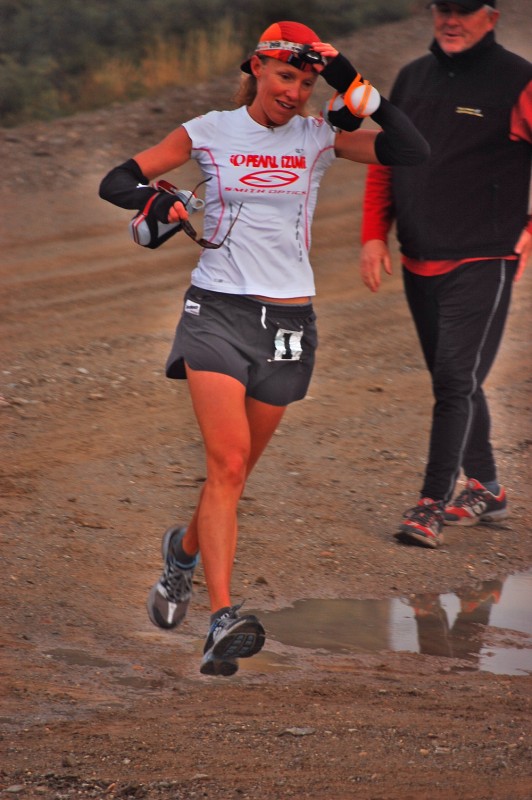 PI-S teammate Darcy Africa completes the male/female sweep. Rick Robinson looking on. Photo: Eric Lee
PI-S teammate Darcy Africa completes the male/female sweep. Rick Robinson looking on. Photo: Eric Lee Nick, Nick and Meltzer at Francis Peak aid. Photo: Nate Grigg
Nick, Nick and Meltzer at Francis Peak aid. Photo: Nate Grigg
I got into the aid a few strides up on Nick (who yelled at me somewhat frantically that we were under course record pace), switched out bottles with Rick and then was on my way down a pitted and puddled forest road. Before long the course markings had me following what appeared to be a game trail through a section of the course that was intensely overgrown. It didn't look like there had been much human movement through these parts in quite some time and I wouldn't be surprised if the people who marked the course were the only people through before me since last year's race. With the overnight rain/snow, I was drenched from the vegetation within seconds, and with the sun still obscured by the clouds it was all a bit chilly. However, the sound of the lively creeks and the fun of bushwhacking kept my spirits up and I popped out from the thicket to emerge at the Bountiful B aid station where I got a refill from Rick and some encouragement from those assembled before heading back out on my way.
To be honest, I don't remember a great deal about the next few sections of the race. I know that there was a good climb in there on a heavily
switchbacked section of trail that was annoyingly slippery at times, I also remember scaring the crap out of a herd of sheep and feeling sorry for the black-coated one among them. There was an absolutely sensational section of net-downhill, yet rolling, ridge running in here too that had me whooping and hollering as the sun had finally burnt away the fog offering up sensational views of valleys and peaks for miles around. I remember feeling very in tune with the run right here and really feeling like I was pushing a good pace.
The next thing I remember with any clarity is crossing a road after a long
switchbacked descent into the Big Mountain aid station where I saw Eric Lee dressed up as the tin man with a pair of tinfoil boobies. It's weird for me to have such vague memories from a run, but really that is about all I remember. There was something of a climb out of Big Mountain and then rollers on well-maintained trail. It was on this trail that I completely missed a turn down to the Alexander aid station. Funnily enough, I distinctly remember seeing the tape hanging high from a tree at the crest of a hill that marked the 90 degree intersection, and I also remember hopping over a couple of small logs on the trail (which of course I thought nothing of as I'd been hopping logs and downed trees all morning) as I passed the marker, but I somehow completely missed the fact that there was a well-defined trail with markers heading down to my right.
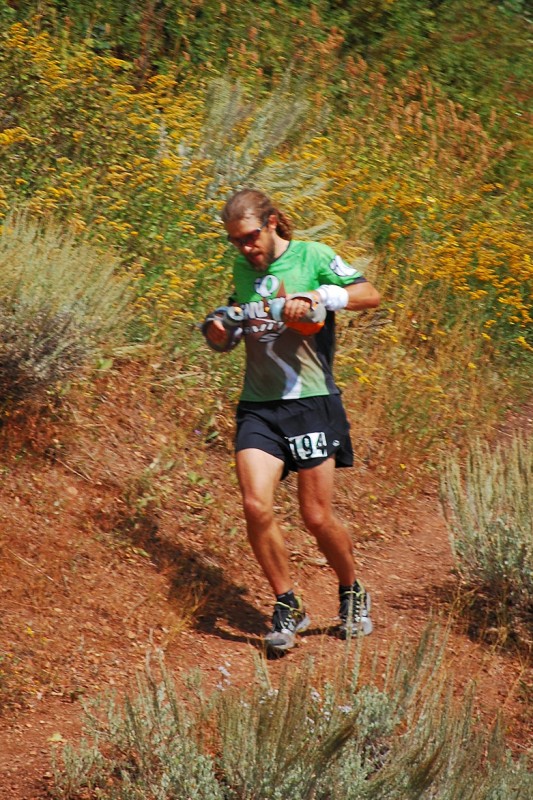 Dropping down into Big Mountain. Photo: Eric Lee
Dropping down into Big Mountain. Photo: Eric LeeAs the trail to this point had not been that regularly marked beyond the key junctions, I thought nothing of the fact that I didn't see a marker for the next 10-15 minutes. However, there comes a point when you think you're off course that you have to make a decision, and as I was starting to sweat the lack of trail markers, another trail intersected the one I was on with no sign of any markers to suggest a turn or to keep going. I unleashed a volley of profanity, but inexplicably kept heading the wrong way down the trail, convinced that the next corner would reveal a dangling duo of blue and pink markers. Five minutes later and I finally gave up on my fools' errand and turned around for the always painful run to get back on course. I timed my return trip to the last-known marker at 18 minutes, so I must have been off course for a total of at least 35 minutes, but I figure it was closer to 40 given that I was foolishly racing to get back on course.
So anyway, I finally got back with the markers and found my turn, and soon thereafter saw some movement ahead. I think Erik
Storheim and his pacer were the first guys I passed on the descent to the Alexander aid, and they told me that they were running in sixth or seventh place. I was pretty demoralized to hear that I was now way back in the pack, but figured that with more than half the course still to cover I could still get back into it if I was sensible and measured about things. Soon after passing Erik, I went by Neal
Gorman and then another guy I didn't recognize. At Alexander, I learned that I was in fourth, a minute or two behind Kevin Schilling and 15-20 minutes behind Nick and Luke.
The section out of Alexander was tough. The trail went through exposed grassland on an uphill gradient that wasn't particularly harsh, but just at that point where you know you need to be running but really don't want to. With the day beginning to heat up noticeably, and with the energy that I had expended trying to get back into the mix, I was really dragging here. I passed Kevin quite soon after the aid, and he was kind enough to offer some encouragement despite the fact that he didn't appear to be in a particularly good place himself.
Rolling into the Lambs Canyon aid station I was slightly buoyed by the fact that I was past the halfway mark. I got various different time checks from people on the course as I was coming in, which varied from 15 minutes to 8 minutes behind Luke and Nick. Rick was right there at the aid and he gave me a fairly serious talking to about taking it easy and realizing that there was still a ton of running still to be done. He was of course right and his sanity helped me cool my jets to get back on with finding a groove that I could take into the finish. Karl
Meltzer and Catherine Horton were also at the aid and offered exactly the same advice, hammering home the need to forget about the missed turn and focus on what lay ahead.
On leaving Lambs, I saw Luke in a chair taping his knee. I didn't realize it at the time, but he was having some serious mechanical issues, which would essentially put him out of the race for positions, but to his immense credit he still gutted out a strong sub-24 hour run. So this put me in second, 8 to 15 minutes behind Nick with a lot of miles and vertical relief still left to cover. All things considered I was pretty happy, although tired, as I made my way up the canyon road to the next section of trail.
The two mile, 1,500 foot climb up Lamb's Canyon was pretty steep, but at just the kind of grade I relish on fresh legs. On this day, I hiked pretty much the whole thing, a fact that indicated that I was really beginning to get tired. As I wasn't running, I focused on regrouping and trying to get a good amount of calories down, all the while thinking that Nick was either in the same boat as me or pulling away significantly. When I finally hit the pass, I felt much better and was able to run the moderately technical and steep descent at a convincingly fast clip. I popped out on the
Millcreek Road feeling good. Rick was right there and informed me that it was 3+ miles of steady uphill, all road, to the Upper Big Water aid, oh and that Nick had just 4.5 minutes on me. I ran the whole stretch up to Big Water at just over a shuffle and finally caught sight of Nick shortly before the aid station, which we essentially entered together.
Having caught sight of the lead, I decided that I would take a few minutes to make sure that I was well fueled for the next climb, so I wasn't concerned at Nick taking off well before me from the aid station. While I don't normally eat aid station food, the chocolate chip cookies they had there were looking (and tasting) particularly good, and I think I consumed five while standing around drinking Sprite, taking another four with me for the climb up to Desolation Lake.
The trail up to Desolation Lake was wide, perfectly groomed and easily the best of the whole race. The grade too was very manageable so I was able to run a good portion of this section. About halfway up, I passed Nick for good. We exchanged a few words, both confessing that we weren't having our best days and wishing each other well for the remainder. I felt good about finally getting back to the front of the field and was hopeful that Nick would hang on for second.
After a steep grunt up to the ridge from the Desolation aid station, there was some really nice ridge running at about 10,000 feet to the Scott's Peak aid station. For all the climbing and gnarly descending that this race throws at you, the high ridges really help lift the spirits. I caught a true second wind on this section and felt like I was gliding into Scott's. The guys there informed me that it was all downhill to Brighton on decent jeep track and then asphalt road. I knew it was five to six hours from Brighton to the finish, which while still intimidating was enough within the realms of a long training run to seem manageable.
Rick had driven Christian, my pacer, up the road to meet me for the run down to Brighton, and I immediately got a boost from his calm energy. We cruised efficiently down the big hill, ran the short uphill to the lodge and geared up for the last 25 miles through the night. I certainly could have been more efficient here, but was again cautious about making sure that I was doing the right things with regards to fueling such that I would get to the finish without a big meltdown.
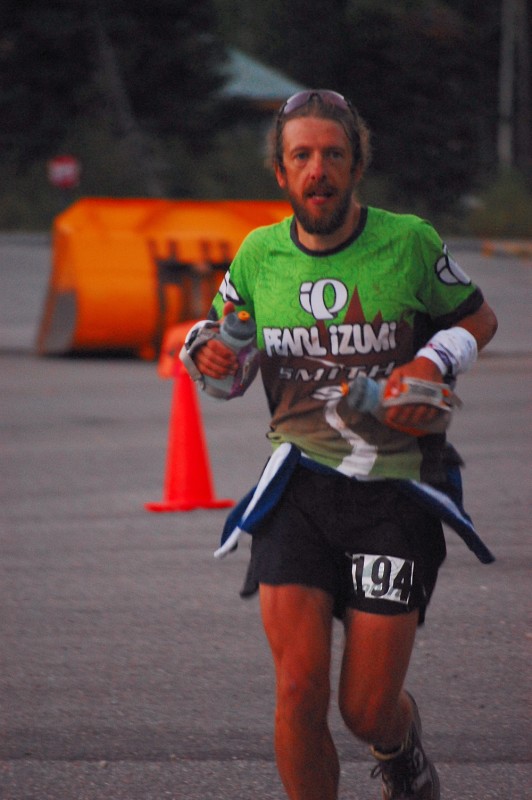 Brighton Lodge parking lot. Photo: Eric Lee
Brighton Lodge parking lot. Photo: Eric LeeChristian and I did a stocktaking of sorts on the climb out of Brighton to the high point in the race, while also pushing out a strong hike and a convincingly strong run around the reservoir, which is where we flipped on the lights for the night. Christian had everything from splits to fuel to sage words of advice and, most importantly, to advance warning of what lay ahead for literally every turn through the last 25 miles. The day before, we had discussed
my desire to get under 20 hours, and while I had given up on any kind of time goals long ago, Christian was adamant that the potential for a 19:xx finish was still a reality. I let him tease me with it for a while, but ultimately knew that I wasn't going to get from Brighton to the Homestead on the legs I had in under 5:20.
As we crested the pass over Sunset Peak, we listened to a coyote howling and then soon after to elk bugling. It was a beautiful night. At Ant Knolls we were told that Anthony
Culpepper was 15 minutes back on us, which had me a little worried, especially as I was convinced I heard cheers soon after we left: an elk whistling, Christian said. The remainder of the run from Ant Knolls came at me in waves of energy and exhaustion, which were mirrored by the relentless nature of the wicked rollers we humped up and down.
My stomach was beginning to go south on me through these rollers, and while I didn't think I was going to launch anything from the abyss, I knew that food and liquid consumption was out of the question until things settled down. My pace dropped noticeably. Right on cue, Christian broke our silence with a menu of items that he was carrying, the first of which was Tums. I hadn't said a word about my stomach, but clearly Christian knew I was fading and so must have figured. I ate a couple of the chalky tablets and soon felt better - not to the point that sickly sweet gel sounded appetizing, but better.
At the next aid, we got a confusing split on Anthony from the prior aid station, which I calculated in my head as 'he's about to pass you,' but which Christian calculated at 25 minutes. I thought he was lying to me to keep me sane, but I said nothing. And then at Pot Bottom all of sudden we were told that the gap was an hour. More confusion and disbelief on my part, but I allowed myself to get caught up in Christian's enthusiasm about the win being a formality.
Coming into Pot Bottom, Christian had given me a root by root, rock by rock and turn by turn verbal preview of the last seven miles, telling me that there was an uphill, yet 'very runnable,' two-mile section of dirt road right off the bat and that we still had a shot at going under 20 hours. I walked 75 percent of the road and verbally threw in the towel on 20 hours soon after we left Pot Bottom. To his credit, Christian was happy to let it go and we cruised the rocky jeep track descent from the dirt road at a steady, but safe clip. I relished the
curvacious last mile or two of
singletrack before we popped out on the road for the one-mile victory lap to the finish.
The soft feel of the grass across the Homestead lawn to the finish was bliss.
The Wasatch 100 is a tough, tough race, with some sections that will bring you to your knees and some others that will leave you breathlessly begging for more. All three of the 100 mile races I have run have been intensely rewarding, but the epic nature of the Wasatch course, mixed with the history and the win probably make this one stand out most for me right now. I went in with little to no expectations and came out the other end with a deep appreciation for the history of this race and the beauty and ruggedness of a sensational mountain range.
It is an absolute honor for me to have my name added as the 31st winner of the Wasatch 100, an honor that heavily outweighs my slight disappointment at not bending under 20 hours. I am indebted to both Christin and Rick for helping me drag my sorry arse across this beautiful mountain range and keeping my head in the game when I could so easily have thrown in the towel. I am of course also indebted to the 350 volunteers who manned aid stations in some very remote (and cold) locations, updated a superb race-tracking website, and provided an impeccably well marked course.
A note of congratulations to the amazingly consistent Neal Gorman, who managed to hang tough for second overall, while also dipping under the 21:30 he needed to set a new cumulative time record for the Grand Slam of Ultrarunning (Western States, Vermont, Leadville, Wasatch), besting Joe Kulak's time from 2003 by a scant quarter of an hour. And another tip of the hat to training partner and friend
Pete Stevenson for persevering on a tough day/night/day in the Wasatch to finish out his Grand Slam quest.
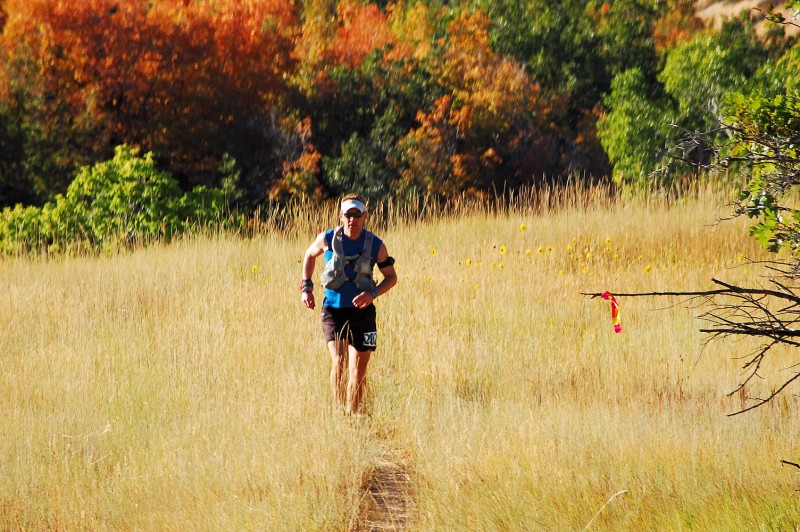
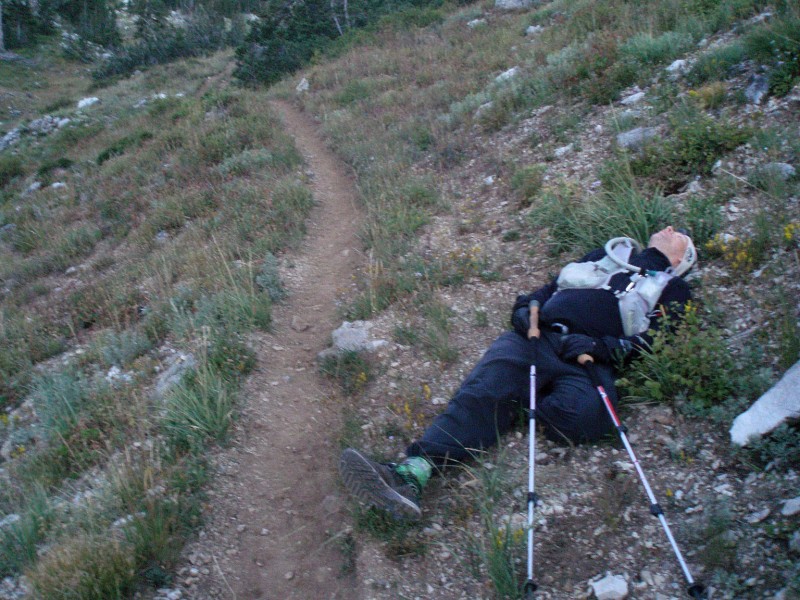 Pete Stevenson at the Wasatch 100. The good and the ugly! Photos: Eric Lee
Pete Stevenson at the Wasatch 100. The good and the ugly! Photos: Eric LeeNow for some rest and a refocus on my beautiful wife, son and impending addition to the family.
 Fun & games at the awards ceremony. Darcy, Nick & Neal G. Photo: Christian Johnson
Fun & games at the awards ceremony. Darcy, Nick & Neal G. Photo: Christian Johnson  Current thinking on the 'Comanche Peaks 50' (not the loop described in the video below, which would involve running in RMNP: Problematic with regards to permitting).
Current thinking on the 'Comanche Peaks 50' (not the loop described in the video below, which would involve running in RMNP: Problematic with regards to permitting).
 Above Beaver Park.
Above Beaver Park. The trail from Flowers dropped a sharp 800' to the Browns Lake cirque, which was thoroughly majestic. This would be a supremely beautiful spot to camp and hang out for a couple of days, but I shot straight through, following the trail that dissected Browns Lake and the smaller Timberline Lake. Sometimes I wish I would take a little more time to enjoy these panoramas, but that's the trade off with trail running, especially the trail running I do, which generally involves maximizing moving time within the time windows I have.
The trail from Flowers dropped a sharp 800' to the Browns Lake cirque, which was thoroughly majestic. This would be a supremely beautiful spot to camp and hang out for a couple of days, but I shot straight through, following the trail that dissected Browns Lake and the smaller Timberline Lake. Sometimes I wish I would take a little more time to enjoy these panoramas, but that's the trade off with trail running, especially the trail running I do, which generally involves maximizing moving time within the time windows I have.







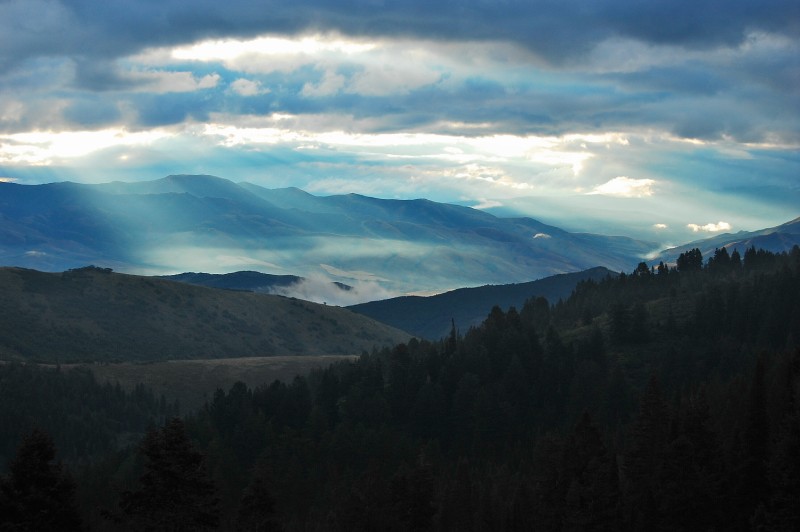
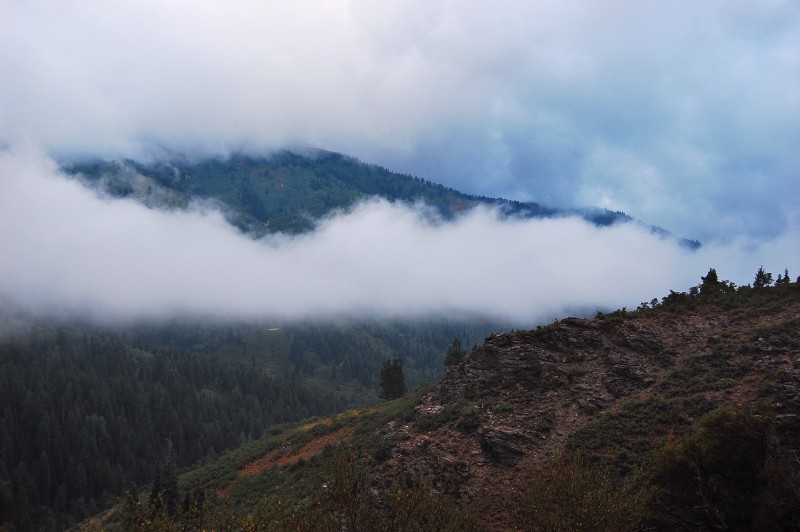
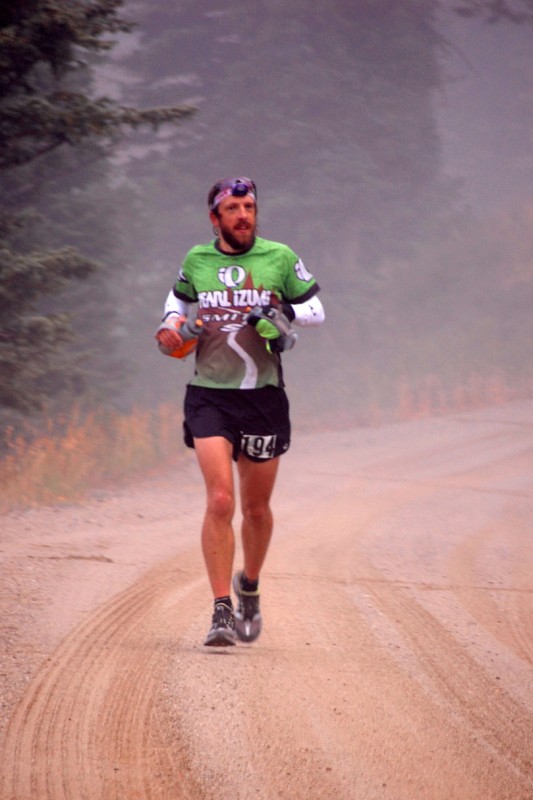







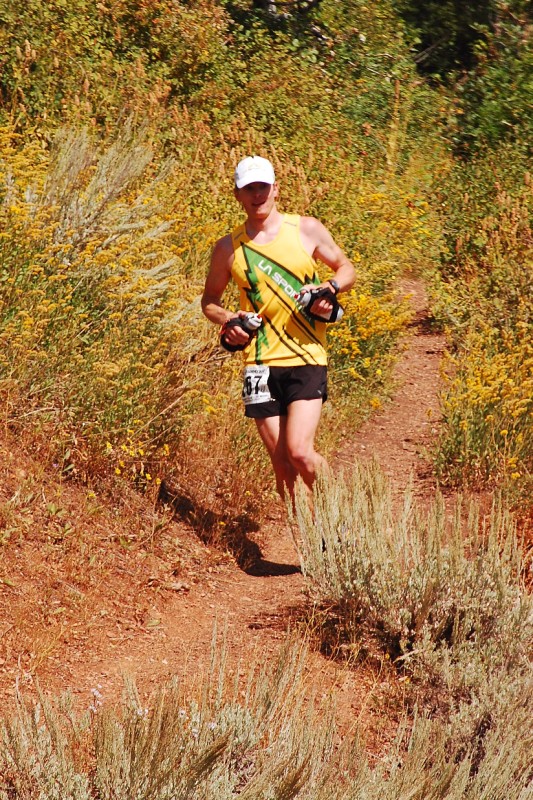

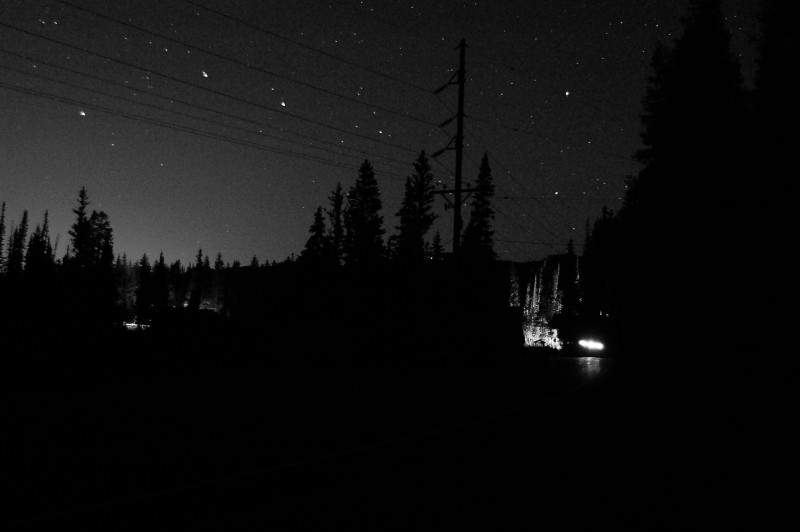
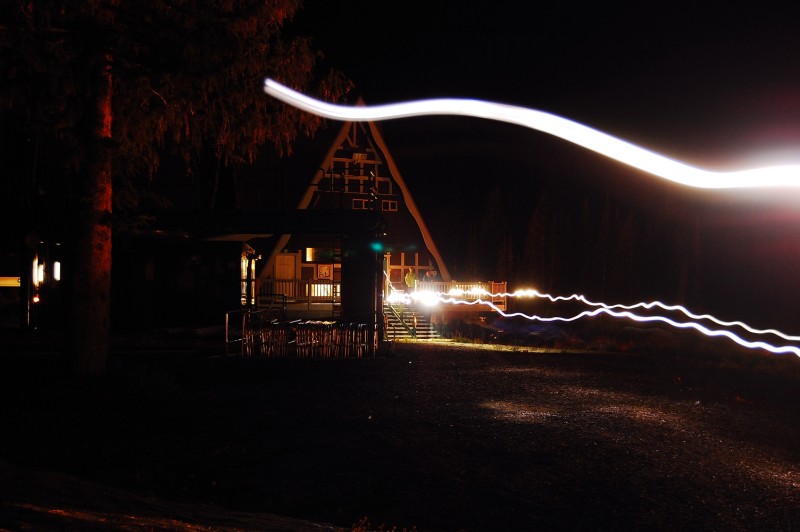







.png)



